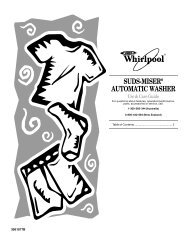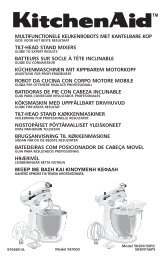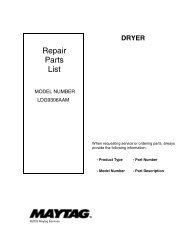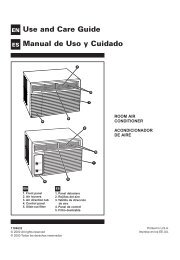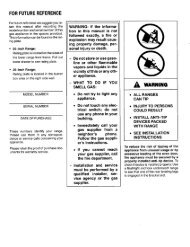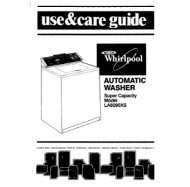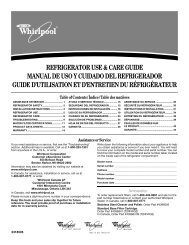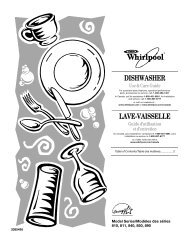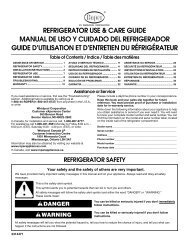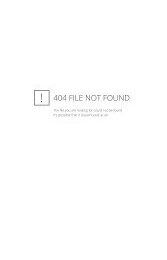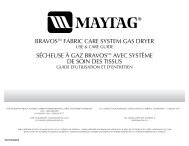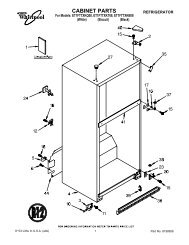electronic electric dryer sécheuse électrique électronique
electronic electric dryer sécheuse électrique électronique
electronic electric dryer sécheuse électrique électronique
Create successful ePaper yourself
Turn your PDF publications into a flip-book with our unique Google optimized e-Paper software.
For a grounded, cord-connected <strong>dryer</strong>:<br />
This <strong>dryer</strong> must be grounded. In the event of malfunction<br />
or breakdown, grounding will reduce the risk of <strong>electric</strong> shock<br />
by providing a path of least resistance for <strong>electric</strong> current. This<br />
<strong>dryer</strong> is equipped with a cord having an equipment-grounding<br />
conductor and a grounding plug. The plug must be plugged<br />
into an appropriate outlet that is properly installed and<br />
grounded in accordance with all local codes and ordinances.<br />
WARNING: Improper connection of the equipmentgrounding<br />
conductor can result in a risk of <strong>electric</strong> shock.<br />
Check with a qualified <strong>electric</strong>ian or service representative or<br />
personnel if you are in doubt as to whether the <strong>dryer</strong> is<br />
properly grounded. Do not modify the plug provided with the<br />
<strong>dryer</strong>: if it will not fit the outlet, have a proper outlet installed<br />
by a qualified <strong>electric</strong>ian.<br />
Venting Requirements<br />
Fire Hazard<br />
Use a heavy metal vent.<br />
Do not use a plastic vent.<br />
Do not use a metal foil vent.<br />
Failure to follow these instructions can result in<br />
death or fire.<br />
WARNING: To reduce the risk of fire, this <strong>dryer</strong> MUST BE<br />
EXHAUSTED OUTDOORS.<br />
4 in. (10.2 cm) heavy metal exhaust vent and clamps must be<br />
used. DURASAFE vent products are recommended.<br />
DURASAFE vent products can be purchased from your dealer<br />
or by calling Whirlpool Parts and Accessories. For more<br />
information, see the “Assistance or Service” section of this<br />
manual.<br />
■ The <strong>dryer</strong> exhaust must not be connected into any gas vent,<br />
chimney, wall, ceiling, or a concealed space of a building.<br />
■ Do not use an exhaust hood with a magnetic latch.<br />
■ Do not install flexible metal vent in enclosed walls, ceilings or<br />
floors.<br />
■ Use clamps to seal all joints. Exhaust vent must not be<br />
connected or secured with screws or other fastening devices<br />
which extend into the interior of the duct. Do not use duct<br />
tape.<br />
IMPORTANT: Observe all governing codes and ordinances.<br />
Improper venting can cause moisture and lint to collect<br />
indoors, which may result in:<br />
Moisture damage to woodwork, furniture, paint, wallpaper,<br />
carpets, etc.<br />
Housecleaning problems and health problems.<br />
Use a heavy metal vent. Do not use plastic or metal foil vent.<br />
Rigid metal vent is recommended to prevent crushing and<br />
kinking.<br />
Flexible metal vent must be fully extended and supported when<br />
the <strong>dryer</strong> is in its final position. Remove excess flexible metal vent<br />
to avoid sagging and kinking that can result in reduced airflow<br />
and poor performance.<br />
An exhaust hood should cap the vent to prevent rodents and<br />
insects from entering the home.<br />
Exhaust hood must be at least 12 in. (30.5 cm) from the ground or<br />
any object that is in the path of the exhaust (such as flowers,<br />
rocks or bushes, etc.).<br />
If using an existing vent system, clean lint from the entire length<br />
of the system and make sure exhaust hood is not plugged with<br />
lint. Replace any plastic or metal foil vent with rigid metal or<br />
flexible metal vent.<br />
Plan Vent System<br />
Typical exhaust installations<br />
Typical installations vent the <strong>dryer</strong> from the rear of the <strong>dryer</strong>.<br />
Other installations are possible.<br />
2<br />
1<br />
5<br />
6<br />
7<br />
8<br />
1. Dryer<br />
2. Elbow<br />
3. Wall<br />
4. Exhaust hood<br />
5. Clamps<br />
6. Rigid metal or flexible metal vent<br />
7. Vent length necessary to<br />
connect elbows<br />
8. Exhaust outlet<br />
3<br />
4<br />
7



